grain
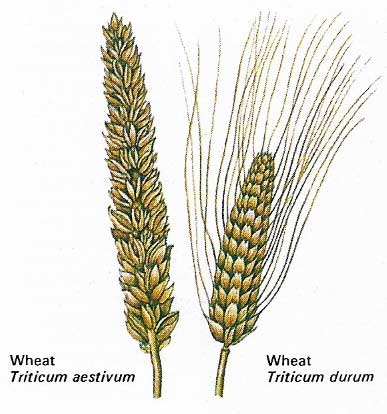
Figure 1. One of the common bread wheats grown extensively throughout the temperate lands is Triticum aestivum. It is a soft, mealy wheat used for flour and biscuit manufacture. Triticum durum, however, is one of the hard wheats. This particular species of wheat is used primarily for grinding into flour that is manufactured into pasta products such as macaroni.
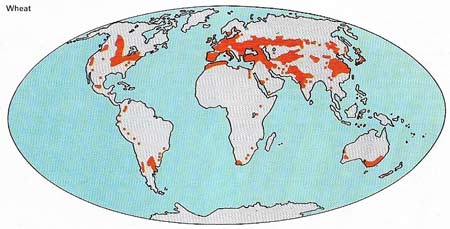
Figure 2. Europe, excluding the USSR, grows about a quarter of the total wheat crop and the yields are the highest in the world. The Soviet wheat belt produces about a quarter of the total. Key areas are in the prairies of America and Canada; India; China; the northern tip of Africa; the temperate zones of Australia; and the South American grain producers – Uruguay, Chile, and Argentina.

Figure 3. Maize (Zea mays) is the key cereal in the subtropical zones of the world. It can yield up to five tons a hectare. Modern techniques of harvesting and storage, and the fact that it is relatively free from most major cereal disease (except blight and fusarium stem rot), have made it a favorite with farmers in developing countries. Hybridization techniques give new varieties that have increased yield potential and disease resistance.
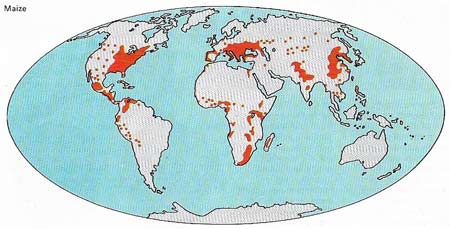
Figure 4. The Corn Belt of the United States produces nearly half of the world's maize, although less and less of this is exported. Most of it is used on farms and supports a vast cattle and pig-producing industry. In Europe, maize is restricted to the warm, damper areas, such as Romania, Yugoslavia, Hungary, and parts of Italy. It is the major cereal crop in Africa but of secondary importance to rice in most Asian countries. Mexico is also a major producer.

Figure 5. Rice (Oryza sativa) is the basic food grain is densely populated monsoon Asia. The husk of the grain has a high silicon content and is dangerous to animals. The outer skin and kernel contains the protein and vitamins. The rice plant is commonly known as paddy, hence paddy fields, and only when it has been harvested and the husk removed does it technically become the rice that is sold.
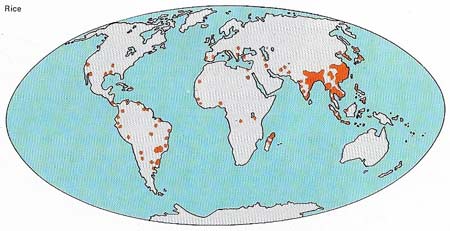
Figure 6. The river deltas ad plains of China and southwest Asia are the main rice-producing areas of the world and up to three or four crops a year are taken off many fields, although this practice soon depletes the soil. China produces an estimated 100 million metric tons while India, Pakistan, and Bangladesh produce 60 million tons. Japan, Thailand, and Vietnam are the other major producing areas.
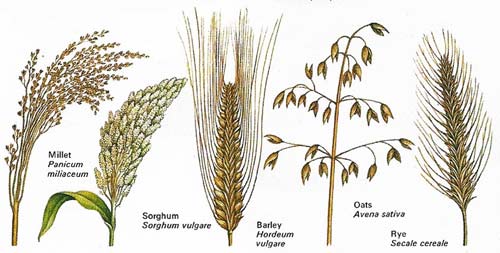
Figure 7. One of the oldest cultivated small grains in the world is millet (Panicum miliaceum), which is grown in tropical Africa. It tolerates prolonged drought and, when exported, is used largely in birdseed preparations. A grain of similar importance in Africa is sorghum (Sorghum vulgare).It is used extensively in the manufacture of beer. Barley (Hordeum vulgare) is one of the principal cereals of temperate agriculture and is widely grown in Europe. America and Australia. Most varieties are spring sown, as they will not tolerate frost during the growing season. Oats (Avena sativa) and rye (Secale cereal) are both thought to have been first noticed growing as weeds in early wheat cultivation. Both cereals are now extensively grown in many parts of Europe, rye proving particularly popular in the glacial soils of central Europe and Russia. Rye grows well in poorer soils than those required for most cereal grains.
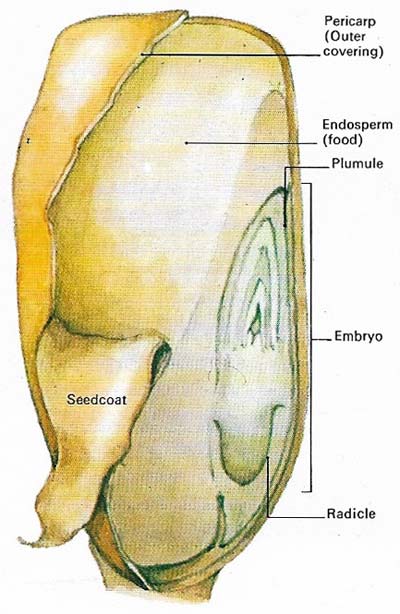
Figure 8. A "seed" of maize (Zea mays) contains both the embryo of the future plant and also the food to nourish it while it germinates. The main food supply, as in all grain crops, lies in a single seed leaf since the plant is a monocotyledon (as distinct from a dicotyledon such as the bean, whose food is contained in two leaves within the seed) and consists predominantly of carbohydrates. It is this food supply that makes the plant economically important. The embryo, made up of the young shoot, the plumule, and the root – the radicle – contains much of the protein of the seed and this was once lost through primitive winnowing techniques. Nowadays the embryo and its protein are saved.
A grain, also known as a caryopsis, is a dry one-seeded fruit, usually containing a high percentage of starch, produced by, for example, corn, oats, barley, rye, and other cereal crops. Grain crops have a high food value, store well, and are a primary food stuff, contributing over half the world's calorie intake.
The history of civilization has always been closely paralleled by the development of cereals – mainly wheat and barley in the world's temperate zones and maize (corn) and rice in the tropical regions.
Wheat and barley
Wheat was perhaps the earliest cereal to he brought into cultivation, the oldest authenticated remains of wheat seeds being found in the excavated site of a seventh millennium BC village in the Tigris-Euphrates valley (now eastern Iraq). Grains there have been matched against wild wheats that still grow in the Near East (Triticum boeoticum and Triticum dicoccoides).
Yields of these early wheats were small compared with those achieved by modern farmers who use more sophisticated varieties and intensive cultivation techniques to harvest up to seven tons a hectare (about three tons an acre). The principal wheat-growing areas are the grassland zones, primarily the steppe regions of Russia and China and the great almost treeless prairies of Canada and the United States (Fig 2).
Two major types of wheat are cultivated today – winter wheat and spring wheat. The former is sown in the autumn in regions where winters are comparatively mild. It grows strongly in the spring for harvest about ten months after sowing. Spring wheat is used in areas where severe winters would kill off the plants of winter varieties. It is sown as soon as the frost leaves the ground and is harvested in late summer – the same time as winter varieties. Winter wheats are higher yielding than spring wheats but produce a lower quality of flour.
Barley (Figure 7) originated in Abyssinia and has been cultivated in Egypt for at least 6,000 years. It grows mainly in the some areas as wheat, although plant-breeding developments have extended barley growing into colder areas. It used to be grown mainly for human consumption as a parched grain or as a meal but today it is used to feed animals and for making malt – which in turn is used for distilling or brewing into alcoholic drinks.
Two other cereals are important in temperate zones – oats and rye (Fig 7). The common oat has been cultivated in western Asia and the Mediterranean countries for about 2,000 years. The main uses are for cattle fodder or for human consumption as a porridge and breakfast cereal. Most rye is grown in eastern Europe and the Soviet Union, as a forage crop for dairy cattle; it is also pounded into flour and used for rye bread.
Maize and rice
Most important of the tropical cereals is maize, now second to wheat in international importance as a food grain (Figures 3 and 4). It was known in America before the Spaniards found the New World, but it probably originated in southern Asia. Today developments in plant breeding are extending the maize-growing areas farther into the temperate zones (Figure 4) by producing hardier strains.
In general, however, maize requires a hot, humid climate and will not tolerate any frost during the growing season. Its main use is as a fodder plant and for manufacturing purposes. The grains are used extensively in animal foodstuffs but also for making starch, and for human consumption as maize meal and cornflakes.
The maize plant may grow to a height of 4.5 meters (15 feet) and with its big, spreading leaves differs greatly from the grass-type cereals such as wheat and barley. In cooler, temperate countries it is now becoming an important forage crop for beef and dairy cattle. The whole maize plant is cut, wilted and stored in a silo for winter feeding.
Although of less importance in world trading terms, rice is perhaps the most vital of cereals (Figures 5 and6). It is said to provide food for more people than any other of the world's cereals. The plant can grow to a height of 1.5 meters (5 feet) and is probably a native of India. It is an annual swamp plant (Figure 8). Unlike the other main cereals, it is not sown directly into the field and left until harvest. Instead, the seeds are sown and when the young plants are big enough they are transplanted into flooded "paddy" fields. These fields are drained at harvest and the rice is then treated like the other small grains and, in developed farming areas, is harvested mechanically with a combine harvester.
The grains of the rice plant are rich in starch. Rice may be ground into a flour but mainly it is husked boiled and eaten, in its original state.
Rice is grown principally in southern and eastern Asia, the great river deltas and alluvial plains forming the main production areas. However, some rice is still produced in hilly areas where the slopes are terraced to allow controlled flooding and draining of the rice field.
The USA has also become an important rice-growing area, and research there has shown that the laborious transplanting of the rice plant is unnecessary and the crop can be drilled directly into the field like other cereals. These techniques are cutting the cost of rice production and encouraging its spread and expansion in other suitable areas.
Millet and sorghum
Another long-cultivated cereal, again native to China, is millet (Figure 7). It grows to a height of about 1 meter (39 inches). Millet tolerates prolonged drought and is grown mainly in the rain-deficient tropical areas of Africa and Asia. Sorghum (Figure 7) is also vital to tropical Africa, where it is the main bread plant.


